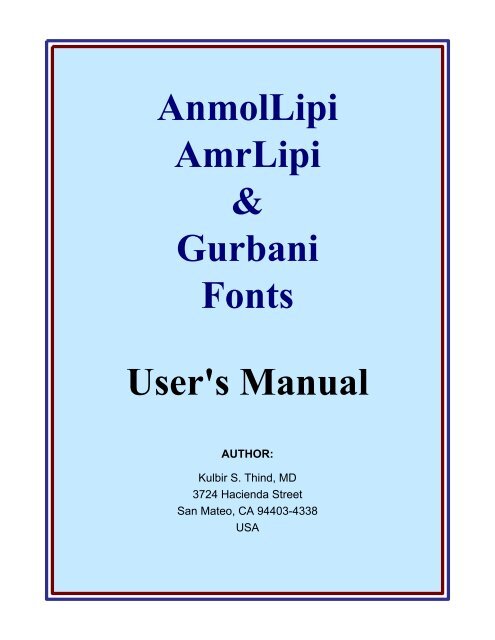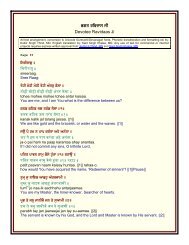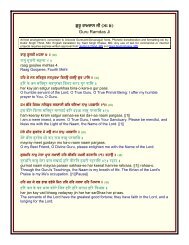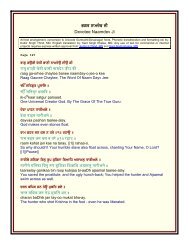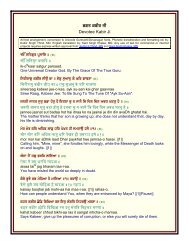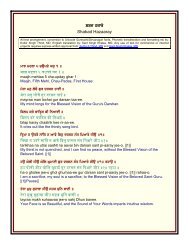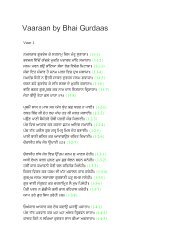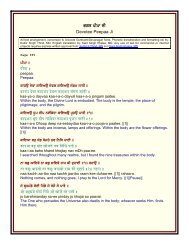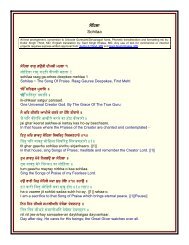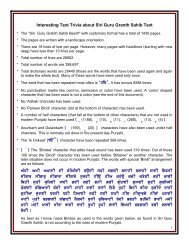Useful fonts manual - gurbanifile - Gurbanifiles.org
Useful fonts manual - gurbanifile - Gurbanifiles.org
Useful fonts manual - gurbanifile - Gurbanifiles.org
Create successful ePaper yourself
Turn your PDF publications into a flip-book with our unique Google optimized e-Paper software.
AnmolLipi<br />
AmrLipi<br />
&<br />
Gurbani<br />
Fonts<br />
User's Manual<br />
AUTHOR:<br />
Kulbir S. Thind, MD<br />
3724 Hacienda Street<br />
San Mateo, CA 94403-4338<br />
USA
2<br />
CONTENTS<br />
# TOPIC PAGE<br />
1. Introduction 3<br />
2. List of Type-Faces provided on the Gurbani-CD 3<br />
3. Licensing Policy 3<br />
4. Assumptions Made for Preparing this Document 4<br />
5. What is a True Type or PostScript Type-1 Type-face? 4<br />
6. Characteristics of Fonts on the Gurbani-CD 4<br />
7. <strong>Useful</strong> Hints and Discussion on the Use of Gurbani & other Fonts 5<br />
8. How are <strong>fonts</strong> on the Gurbani-CD Different from Amrit-Lipi? 8<br />
9. Important Information about Conversion of Amrit-Lipi Documents to<br />
GurbaniLipi Documents<br />
10. Important Information About Seemingly Duplicate Characters in the<br />
<strong>fonts</strong> on the Gurbani-CD.<br />
11. Information about Key Mapping 12<br />
12. Information about Transfer of Files between PC (MS windows) &<br />
Macintosh Computers<br />
13. General Information about Amrit-Lipi, Gurbani & other Fonts 15<br />
14. Disclaimer 16<br />
15. A Final Note 16<br />
9<br />
11<br />
15<br />
NOTE: This <strong>manual</strong> does not refer to the <strong>fonts</strong> included inside the "Ramingt_"<br />
folder on the Gurbani-CD. The terms "<strong>fonts</strong> on the Gurbani-CD" or "<strong>fonts</strong><br />
included on the Gurbani-CD" are loosely used in this <strong>manual</strong> and do not relate to<br />
the <strong>fonts</strong> inside the "Ramingt_" folder.<br />
All rights are reserved by the author, Kulbir S Thind, MD, 3724 Hacienda Street, San Mateo, CA 94403, USA.
3<br />
INTRODUCTION:<br />
Information in this document is designed to help you successfully use the <strong>fonts</strong><br />
provided on the Gurbani-CD. This document is prepared with a number of <strong>fonts</strong><br />
including many from the Gurbani-CD. Thus, before attempting to read or print this<br />
document the user should install the <strong>fonts</strong> provided on the Gurbani-CD by opening<br />
"InstalTT.doc" document on the Gurbani-CD. This document may be printed for easy<br />
reference.<br />
This <strong>manual</strong> has information both for PC & Macintosh computers. Please use the<br />
information that is appropriate for your computer.<br />
List of Type-Faces provided on the Gurbani-CD (inside the “FONTS” folder):<br />
1. “AnmolLipi type-faces”, (AnmolLipi, AnmolLipiLight, AnmolLipiSlim, AnmolLipi-<br />
Bold, AnmolLipiThick, AnmolRaised, AnmolUbhri, AnmolKalmi) are a family of<br />
Gurmukhi <strong>fonts</strong> with variations in display that are suitable for writing modern<br />
Punjabi where international numbers are used as a routine. Classic Gurmukhi<br />
number characters are also included in these <strong>fonts</strong> as symbols.<br />
2. “AmrLipi type-faces”, (AmrLipi, AmrLipiLight, AmrLipiSlim, AmrLipiHeavy,<br />
AmrLipiThick etc.) are a family of Gurmukhi <strong>fonts</strong> with variations in display that are<br />
suitable for writing Punjabi where classic Gurmukhi numbers are used as a routine.<br />
3. “GurbaniAkhar type-faces”, (GurbaniAkhar, GurbaniAkharLight,<br />
GurbaniAkharSlim & GurbaniLipiHeavy, GurbaniAkharThick etc.) are a family of<br />
Gurmukhi <strong>fonts</strong> with variations in thickness that are optimized for writing text of<br />
Shree Guru Granth Sahib in the customary format (i.e.; these <strong>fonts</strong> fulfill the<br />
requirement of writing 19 lines of Gurbani text per page in the landscape page<br />
orientation and with a decent font size). Most characters in these <strong>fonts</strong> have lesser<br />
width than the AnmolLipi or AmrLipi family of type faces (due mainly to less of<br />
white space around the characters). Additionally, in the GurbaniAkhar family of<br />
type-faces more of space is given to the characters that fall below the base line.<br />
These <strong>fonts</strong> have been further improved over GurbaniLipi <strong>fonts</strong>.<br />
4. “GurbaniLipi & GurbaniLipiLight”, along with their bold versions are a family of<br />
Gurmukhi <strong>fonts</strong> with variations in thickness that are optimized for writing text of<br />
Shree Guru Granth Sahib in the customary format.<br />
5. “GurbaniHindi, Guru Devan, ApniHindi, AmrHindi”, are Devanagari (Hindi)<br />
<strong>fonts</strong>.<br />
6. “GurbaniRomanizing”, a font optimized for romanizing Gurbani (& Gurmukhi).<br />
Many bitmap <strong>fonts</strong> are also included for the Macintosh computer.<br />
All of the above <strong>fonts</strong> share similar (although not identical) key maps. Devanagari <strong>fonts</strong><br />
have many more characters than are available in Gurmukhi <strong>fonts</strong>.<br />
All rights are reserved by the author, Kulbir S Thind, MD, 3724 Hacienda Street, San Mateo, CA 94403, USA.
4<br />
Licensing Policy<br />
Dr. Thind’s Type-faces are free but are licensed for use only. Users are not permitted to<br />
illegally sell his type-faces or to modify the outlines for making profit or for other<br />
purposes. They are also not to distribute copies of his type-faces to others, free or<br />
otherwise. The distribution should be left to Dr. Thind and to individuals authorized by<br />
him as there are many advantages in doing so. If you do want to give Dr. Thind’s <strong>fonts</strong><br />
to others, you must, first obtain permission from him.<br />
Assumptions Made in Preparing this Document<br />
It is assumed that the users of the <strong>fonts</strong> included on the Gurbani-CD <strong>fonts</strong> have<br />
sufficient familiarity with MS Windows Operating System or Macintosh Operating<br />
System and should be able to use at least some word processing programs (that run<br />
under the system in question).<br />
What is a True Type or PostScript Type-1 Type-face?<br />
True Type or PostScript Type-1 type-faces are called outline type-faces. These consist<br />
of mathematical descriptions of the outlines of characters. Such type-faces can be<br />
scaled 2 to any practical size for smooth display on the monitor or for printing on many<br />
different printers (including postscript printers). However, these type-faces can only be<br />
used with the help of a certain type of system software that is made to use these kind of<br />
type-faces. All of presently sold Macintosh computers can use TrueType as well as<br />
PostScript Type-1 <strong>fonts</strong>. MS Windows 95 or later versions of Windows can all use<br />
TrueType <strong>fonts</strong>. MS Windows 2000 & XP can also use PostScript Type 1 <strong>fonts</strong>.<br />
However, Adobe Type Manager software is required to use PostScript Type-1 <strong>fonts</strong> on<br />
Windows 95, 98 & NT.<br />
Characteristics of Fonts on the Gurbani-CD<br />
1. These <strong>fonts</strong> have a well thought character layout. These type-faces are expected<br />
to be used on the computers with English keyboards. There are more than 125<br />
working characters in each of these type-faces and 94 of those can be accessed<br />
as upper and lower case characters. Devnagari type-faces have many more<br />
characters to make it suitable for writing Hindi. GurbaniRomanizing type-face is<br />
optimized for romanizing GurbaniLipi text with ease. Ease of remembering the<br />
location of characters was one factor that played a major role in deciding mapping<br />
of characters. However, many other issues such as convertibility of files between<br />
the Macintosh and IBM compatible PCs were taken into consideration. The most<br />
important characters are available as upper and lower case and are arranged in a<br />
2 With the help of proper software, such type-faces can also be rotated and outlines of their characters<br />
manipulated to produce many types of visual effects, such as skewing, stretching, compressing, twisting<br />
and distributing. With these type-faces, you can routinely use effects such as bolding, underlining,<br />
outlining, shadowing and italicizing.<br />
All rights are reserved by the author, Kulbir S Thind, MD, 3724 Hacienda Street, San Mateo, CA 94403, USA.
5<br />
way to make it easier to remember their arrangement. Please see more regarding<br />
key mapping under “Information about Key Mapping.”<br />
2. Type-face size is balanced for esthetic mixing with the popular English type-faces<br />
(without the need to change size).<br />
Some useful Hints and Discussion on the Use of Fonts on the Gurbani-CD.<br />
Which software can use these Fonts?<br />
Once the <strong>fonts</strong> are installed into your computer’s system, those then become available<br />
to any of the software that runs under that system. Almost all of the software designed<br />
for the Macintosh computers is capable of using different <strong>fonts</strong>. The situation is very<br />
much similar with most of the software made for MS Windows. A software that runs<br />
under DOS but not under Windows can not make use of these type-faces (for example<br />
“Microsoft Word for Windows” can make use of these type-faces but “Microsoft Word for<br />
DOS” can not).<br />
Typing Fonts Included on the Gurbani-CD<br />
Assuming that the <strong>fonts</strong> are installed into your system and you are running an<br />
appropriate software. To create a document using the Gurmukhi or Hindi <strong>fonts</strong>, you will<br />
need to select the appropriate font from the "Fonts" menu and its intended size from the<br />
font-size menu. To type the appropriate characters one needs to refer to the charactermap<br />
(character layout on the key board and ANSI numbers-in case of MS Windows<br />
operating system). Memorizing the key map will help in gaining speed in typing these<br />
Gurmukhi or Hindi <strong>fonts</strong>. With practice one can get used to the character map and to<br />
other peculiarities of typing and editing Gurmukhi & Hindi <strong>fonts</strong>. Users should refer to<br />
the character maps that are included on the Gurbani CD.<br />
To achieve consistent results (especially for creating & using spell-checking dictionaries<br />
and for “Find & Replace” functions) it is important to use a standard method of<br />
sequencing the characters. Due to the existence of overlapping characters in the<br />
Gurmukhi <strong>fonts</strong> this issue becomes too important to ignore. When two overlapping<br />
characters are used one after the other it is hard to tell their sequence just by looking at<br />
a word. Whenever it is necessary to type two overlapping characters, the<br />
overlapping character at the bottom of the main character on the left should be<br />
typed first. Thus, the word nUµ should be typed as “nUµ” (the ANSI number for µ is 181<br />
and on the Macintosh computer this word is typed “Option M” for µ). Only in rare<br />
instances two overlapping characters like in DR¨ fall beneath the character on the left. In<br />
such situations proper sequence is usually obvious.<br />
When writing “Gurmukhi” it is advisable that “AutoCorrect” feature of your Word<br />
Processor be adjusted so that it may not correct two consecutive capitals in a<br />
word and should not capitalize first letter of sentenses. In case of “Microsoft Word”<br />
this feature can be adjusted by selecting the command “AutoCorrect” from the tools<br />
menu and then deselecting “Correct TWo INitial CApitals” and "Capitalize First Letter of<br />
Sentenses" in the dialogue that follows.<br />
All rights are reserved by the author, Kulbir S Thind, MD, 3724 Hacienda Street, San Mateo, CA 94403, USA.
6<br />
Viewing Fonts in Detail<br />
It is important to emphasize the fact that even a good quality monitor will not display a<br />
very small size of characters with clarity (and for a very small size of text, Windows<br />
often will change the type-face to a proprietary one). This is mainly due to the limitations<br />
of display resolution. Print quality depends to a great extent on the printer you use. A<br />
good quality printer can print many times more dots per inch than what most of good<br />
monitors can display. Commonly used laser printers print 300 dots per inch or 90,000<br />
dots per square inch, whereas most of the computer monitors show about 75 dots per<br />
inch or 5625 dots per square inch; the difference is 16 fold. However, most of the<br />
computer monitors have one distinct edge over most of the printers. Computer monitors<br />
can show many colors and each dot can display a color by picking among millions,<br />
whereas dots in most of the printers are printed with one bit mode (like black or white)<br />
and gray tones or colors are simulated by combining such dots.<br />
To have a real (detailed) look of any character shape it is important to view the<br />
character at a large point size. Most of present day word processors allow you to type<br />
large size of text. Text at point size of 100 or above may be used for a detailed look. As<br />
seen on the monitor, character shapes at small sizes are somewhat of a compromise,<br />
although those will be printed perfect with a good quality printer. Slim versions of <strong>fonts</strong><br />
give a clearer view of the smaller point sizes of text on the monitor than medium or thick<br />
versions of <strong>fonts</strong>. Depending on your printer, thinner versions of <strong>fonts</strong> will generally print<br />
smaller sizes of text sharper than thicker <strong>fonts</strong>.<br />
At certain point sizes, bolding of certain <strong>fonts</strong> (if you have installed bolder versions of<br />
these <strong>fonts</strong>) may not be obvious on the monitor. It is because pixels (dots) on the<br />
screen can not be divided into fractions. Under circumstances requiring pixel fractions<br />
for bolding of the text, the computer may not add a visible thickness to make bolding<br />
obvious. However, the text when printed with a good quality printer, will be perfectly<br />
bold if there is a bold version of the font installed in the system. (Note: if there is no<br />
installed bold version of a type-face then bolding is done by the software itself and is<br />
almost always obvious on the monitor. However, the printed bold text in such cases is<br />
not perfect like when a bold version of the font is available).<br />
Experience indicates that the PostScript Type-1 <strong>fonts</strong> seem to give better results as far<br />
as character clarity on the monitor is concerned and also to a good extent in printing.<br />
Due to internal limitations, the True-Type <strong>fonts</strong> often do not print or display complex<br />
characters well.<br />
Accessing Characters<br />
True Type type-face technology was originally designed by Apple for use on the<br />
Macintosh. Microsoft also licensed & developed “TrueType” for the Windows. So far as<br />
the use of the type-faces is concerned, presently there is not much difference between<br />
these environments. However, it is much easier to access type-face characters on the<br />
Macintosh that exceed the upper & lower case limit (94). It is due to the availability on<br />
the Macintosh of ‘Command’, ‘Option’ & ‘Shift + Option keys’. By pressing one or a<br />
All rights are reserved by the author, Kulbir S Thind, MD, 3724 Hacienda Street, San Mateo, CA 94403, USA.
7<br />
combination of these keys, a full array of 47 more characters becomes easily<br />
accessible, just as with the Shift key. In the Windows environment, a common way to<br />
access the extra characters is to hold the Alt key in the pressed position and then type<br />
on the numeric key pad a zero "0" followed by the ANSI number of the character. Some<br />
of the software for the Windows environment also provide other means of accessing<br />
characters in excess of upper & lower case (for example, MS Word for Windows has a<br />
command named “Insert Symbol” which is very helpful in this regard). Version 6.0 or<br />
later versions of MS Word allow one to allocate key combinations to insert such<br />
characters with ease. With this facility, typing becomes as easy as on Macintosh.<br />
Although the operating system of Windows itself does not provide the ease of accessing<br />
more than 94 characters like the Macintosh environment does, something similar can<br />
however be achieved by many of the working software. One of the ways the word<br />
processors (and other software) achieve this is by allowing one to create macros. Short<br />
of other means, the “Character Map” utility that comes with the Windows 95 or later<br />
versions of Windows is helpful in providing some ease. Since “Windows” allows one to<br />
run “Character Map” utility simultaneously with one’s working software, it is easier to<br />
make use of this utility. It may be convenient to keep “Character Map” utility running<br />
while typing Gurmukhi or Hindi <strong>fonts</strong>.<br />
Editing Gurmukhi or Hindi Fonts<br />
To help edit characters that overlap over or under the character on the left, such<br />
characters are assigned a small width. While editing, it is always tricky to get the cursor<br />
on the right side of such a character (with essentially no width) but it can be done if care<br />
is exercised - just insert the cursor a little bit more to the right. The use of cursor arrow<br />
keys is also very useful in this regard. Although generally not a problem, inserting the<br />
cursor on the left side of an overlap character may also require precision. It may be<br />
convenient to use bigger type-face size while typing the text. Upon completion of the<br />
work (after all the text has been entered), the text size can then be reduced to the<br />
desired level.<br />
Use of Special Space Character (non-breaking space)<br />
This paragraph describes the special “space” character (ANSI # 160 for MS Windows<br />
and “Option Space” for the Macintosh) in the supplied and other <strong>fonts</strong>. This is different<br />
from the regular space character that is typed with the space bar. A regular space<br />
character separates the words but this “solid space” character behaves like other<br />
characters and has width but no shape. When this non-breaking space character is<br />
typed, it adds white space to words. This kind of space always behaves as a part of the<br />
word and moves with it (unlike the space character typed with the space bar). This<br />
character is useful in many situations. Here is a good example of its use. The<br />
overlapping GurbaniLipi character “ y ” will be displayed when there is a character on<br />
All rights are reserved by the author, Kulbir S Thind, MD, 3724 Hacienda Street, San Mateo, CA 94403, USA.
8<br />
the left side. 3 In this case a solid space character has been used (twice). In this<br />
example therefore “ y ” behaves as one word.<br />
How are Fonts on the Gurbani-CD Different from Amrit-Lipi?<br />
Dr. Thind’s Amrit-Lipi <strong>fonts</strong> had a wide distribution before GurbaniLipi was made<br />
available. “GurbaniLipi” is a special Gurmukhi font optimized for writing Guru Granth<br />
Sahib. Since then other <strong>fonts</strong> included on the Gurbani-CD have been developed. The<br />
following eleven characters previously not found in the Amrit-Lipi have been included in<br />
the “GurbaniLipi and other <strong>fonts</strong> that followed.” (See acknowledgment at the bottom of<br />
this page) **<br />
@ ´ ç † œ ˜ ü ¨ Ú Ø<br />
The areas are shaded simply to illustrate the relationships of characters to the<br />
_______________________________________________________________<br />
Shapes for ç † œ ˜ Í vary in different printed versions of Guru Granth Sahib and also<br />
within the same edition. In the <strong>fonts</strong> included on the Gurbani-CD the characters ç † œ ˜<br />
are open at the tops (as suggested by Dr. Kulwant Singh). The eleventh character<br />
shown above is a dot character that can be used to put a bindi (dot) under any<br />
character. This is essentially an extra character. The right upward sloped part of <br />
is more sloped. There are two tippi characters in the Amrit-Lipi as well as in the<br />
GurbaniLIpi <strong>fonts</strong>. However, the key map locations of these tippi characters is reversed<br />
as compared to Amrit-Lipi. See details under “Important Information about Seemingly<br />
Duplicate Characters in the Gurmukhi Fonts on the Gurbani-CD”.<br />
The keyboard mapping of <strong>fonts</strong> on the Gurbani-CD is improved and allows one to create<br />
and use the spell checking dictionaries. For the same reason, an extra character ~ that<br />
is required after a is included in these <strong>fonts</strong>. See more regarding this under “Important<br />
Information About Seemingly Duplicate Characters in the Gurmukhi <strong>fonts</strong> on the<br />
Gurbani-CD.” Key maps of these <strong>fonts</strong> are easier to remember and make it possible to<br />
access few more characters as upper and lower case.<br />
Many a <strong>fonts</strong> of the Gurbani-CD have also been improved by modifying character<br />
shapes so as to make characters more clear on the computer monitor (clarity problems<br />
are only an issue at smaller sizes of text) and for low resolution printing.<br />
It needs to be clarified that the minimum line spacing in the <strong>fonts</strong> on the Gurbani-CD is<br />
more than in “Amrit-Lipi.” However, it is possible to adjust line spacing below the<br />
minimum allowed in the font by using fixed spacing. But not all word processors allow<br />
fixed spacing. Care should be exercised when using fixed line spacing as characters<br />
3 Some of the software will display and print such characters regardless of whether there be a character<br />
on the left or not.<br />
** The labor of searching all the special characters in Shri Guru Granth Sahib was done by Dr. Kulwant<br />
Singh. Dr. Thind is grateful to him. The extra dot character is also included as per his suggestion.<br />
All rights are reserved by the author, Kulbir S Thind, MD, 3724 Hacienda Street, San Mateo, CA 94403, USA.
9<br />
between lines can overlap each other and in some cases may get cut depending upon<br />
your computer/printer setup.<br />
Important Information about Conversion of Amrit-Lipi Documents to Documents<br />
Using <strong>fonts</strong> given on the Gurbani-CD<br />
AnmolLipi, AmrLipi, GurbaniAkhar & GurbaniLipi, families of <strong>fonts</strong> have similar key<br />
maps. However, these <strong>fonts</strong> have a somewhat different key map than the Amrit-Lipi<br />
<strong>fonts</strong>. These <strong>fonts</strong> are not only good for writing Gurbani & modern Gurmukhi, but are<br />
also nearly perfect for creating & using Gurmukhi dictionaries and for flexible “Find &<br />
Replace” functions. Thus many of you may want to update your existing documents for<br />
use with these <strong>fonts</strong>. This information is for those individuals who need to update their<br />
old documents containing Amrit-Lipi <strong>fonts</strong> to those with GurbaniLipi or similar <strong>fonts</strong>.<br />
However, there is a point of caution. The tables below ignore conversions for extra set<br />
of numbers (the numbers in the natural number locations do not require any<br />
conversions). Extra set of numbers are probably never used by most of individuals.<br />
The documents prepared using Amrit-Lipi <strong>fonts</strong> can be converted to GurbaniLipi<br />
documents (or those with other similar <strong>fonts</strong>) by using “Find & Replace” functions of<br />
your word processor. If you prepared your documents by using Microsoft Word, you<br />
may use a readymade macro from Dr. Thind to do the conversions with one command.<br />
Otherwise use the “Find & Replace” functions of your word processor and follow the<br />
sequence of replacements as outlined below.<br />
To safeguard your document from possible blunders during the conversion<br />
process the following “Find Replace” functions should be performed on a copy of<br />
the original document. Before conversion do not add your written material<br />
prepared with new <strong>fonts</strong> to your old documents before conversion.<br />
As the first step change document <strong>fonts</strong> from Amrit-Lipi font to AnmolLipi with the “Find<br />
& Replace” command.<br />
Next step involves replacing each of the appropriate letters in a defined sequence as<br />
shown in the tables. Make sure that you check “Match Case” but not “Whole Words<br />
Only.” The font selection must be “AnmolLipi” font for “Find What” as well as for<br />
“Replace With” (unless after font conversion the only font in your whole document is<br />
AnmolLipi).<br />
“Replace” Sequences for “Amrit-Lipi2 or Amrit-Lipi-Light to AnmolLipi” in MS<br />
Windows environment.<br />
Note: The numbers in the “Find What” or “Replace With” columns denote the ANSI number of the respective<br />
character.<br />
#<br />
Find<br />
What<br />
Replac<br />
e With #<br />
Find<br />
What<br />
Replace<br />
With #<br />
Find<br />
What<br />
Replace<br />
With #<br />
Find<br />
What<br />
Replac<br />
e With<br />
1 W \ 7 @ ` 13 E A 19 nM n+18<br />
1<br />
All rights are reserved by the author, Kulbir S Thind, MD, 3724 Hacienda Street, San Mateo, CA 94403, USA.
10<br />
2 ~ W 8 172 163 14 132 E 20 lM l+181<br />
3 | [ 9 229 15 151 133 21 210 ]<br />
4 X | 10 212 199 16 174 151 22 211 nU+181<br />
5 w X 11 171 162 17 181 M<br />
6 ` w 12 A 132 18 kR k+174<br />
“Replace” Sequences for “Amrit-Lipi-M or Amrit-Lipi-Light-M to AnmolLipi” in<br />
Macintosh environment.<br />
Note: The key combinations for the specific characters are given in the parenthesis in the respective cells.(the<br />
letter S is for the Shift key and O is for the Option key).<br />
#<br />
Find<br />
What<br />
Replace<br />
With #<br />
Find<br />
What<br />
Replace<br />
With #<br />
Find<br />
What<br />
Replace<br />
With #<br />
Find<br />
What<br />
Replace<br />
With<br />
1 W \ 7 @ ` 13 E A 19 nM nµ<br />
(n+Om)<br />
2 ~ W 8 ¬<br />
(Ol)<br />
3 | [ 9 å<br />
(Oa)<br />
4 X | 10 Ô<br />
(SOj)<br />
5 w X 11 «<br />
(O\)<br />
£<br />
(O3)<br />
14 ∂<br />
(Od)<br />
15 —<br />
(SO-)<br />
Ç<br />
(SOc)<br />
¢<br />
(O4)<br />
6 ` w 12 A ∂<br />
(Od)<br />
16 ®<br />
(Or)<br />
17 µ<br />
(Om)<br />
E 20 lM lµ<br />
(l+Om)<br />
…<br />
(O;)<br />
—<br />
(SO-)<br />
M<br />
18 kR k®<br />
(k+Or)<br />
21 Ò<br />
(SOl)<br />
22 Ó<br />
(SOh)<br />
]<br />
nUµ<br />
(n+U+Om)<br />
There is only one “Adhak” character in the Amrit-Lipi & Gurbani-Lipi <strong>fonts</strong>. For proper<br />
spell checking it is important to use the additional “Adhak” as provided in the<br />
GurbaniLipi when required after any “Oorha” character. Such corrections will have to be<br />
done <strong>manual</strong>ly. It is possible to easily search words with characters that follow another<br />
character after the “Oorha.” In Microsoft Word 6.0 a find inquiry “ a?`” will locate such<br />
words.<br />
“Replace” Sequences to correct the improper character sequences in the MS<br />
Windows environment.<br />
Note: The numbers in the “Find What” or “Replace With” columns denote the ANSI number of the<br />
respective character. The replace sequences listed in the table below are for frequently written material.<br />
Many more sequences are possible in the text from Sikh scriptures. Interested individuals may contact<br />
Dr. Thind for details.<br />
Find Replac Find Replac Find Replace Find Replac<br />
# What e With # What e With # What With # What e With<br />
1 Mu uM 7 MU UM 13 oR Ro 19 `R R`<br />
2 181+u u+181 8 181+U U+181 14 OR RO 20 MH HM<br />
All rights are reserved by the author, Kulbir S Thind, MD, 3724 Hacienda Street, San Mateo, CA 94403, USA.
11<br />
3 `u u` 9 `U U` 15 yR Ry<br />
4 ~u u~ 10 ~U U~ 16 YR RY<br />
“Replace” Sequences to correct the improper character sequences in the<br />
Macintosh environment.<br />
Note: The key combinations for the specific characters are given in the parenthesis in the respective cells.(the<br />
letter S is for the Shift key and O is for the Option key). The replace sequences listed in the table below are<br />
for frequently written material. Many more sequences are possible in the text from Sikh scriptures.<br />
Interested individuals may contact Dr, Thind for details.<br />
Find Replace Find What Replace<br />
Find Replace Find Replac<br />
# What With #<br />
With # What With # What e With<br />
1 Mu uM 7 MU UM 13 oR Ro 19 `R R`<br />
2 µu uµ 8 µU Uµ 14 OR RO 20 MH HM<br />
(Om+u) (u+Om) (Om+U) (U+Om)<br />
3 `u u` 9 `U U` 15 yR Ry<br />
4 ~u u~ 10 ~U U~ 16 YR RY<br />
Important Information About Seemingly Duplicate Characters in the Fonts on the<br />
Gurbani-CD.<br />
Following table illustrates differences between double characters in the these <strong>fonts</strong>:<br />
MS Windows environment:<br />
Character Key or ANSI<br />
#<br />
Shape Placement Example<br />
M<br />
µ<br />
Shift M sM isMG<br />
ANSI #181 sµ plµG, nUµ<br />
` ` s` iv`c<br />
Shift ` (~) ~ s~ au~cy<br />
u<br />
ü<br />
u su buD<br />
ANSI #252 sü dRügMDw<br />
U<br />
¨<br />
Shift U sU pUrw<br />
ANSI #168 s¨ DR¨<br />
Shift N N sN pING<br />
ANSI #136 ˆ sˆ AMDˆØI ***<br />
Shift R ªR sR ipRQvI<br />
*** A Gurbani word that requires a bar character (ANSI#216) to be typed between bindee & biharee.<br />
All rights are reserved by the author, Kulbir S Thind, MD, 3724 Hacienda Street, San Mateo, CA 94403, USA.
12<br />
ANSI #174 ª® s® ik®pwl<br />
Macintosh environment:<br />
Character Key Shape Placement Example<br />
M<br />
µ<br />
Shift m sM isMG<br />
Option m sµ plµG, nUµ<br />
` ` s` iv`c<br />
Shift ` (~) ~ s~ au~cy<br />
u<br />
ü<br />
u su buD<br />
Option uu sü dRügMDw<br />
U<br />
¨<br />
Shift u sU pUrw<br />
Shift Option u s¨ DR¨<br />
ˆ<br />
Shift N N sN pING<br />
Shift Option i sˆ AMDˆØI ***<br />
Shif R ªR sR ipRQvI<br />
Option r ª® s® ik®pwl<br />
The “double-dundee” characters with key map “]” & ANSI #210 (Shift Option l) are<br />
different only in the amount of white space on their sides. The character with ANSI#210<br />
(Shift Option l) has very little of white space on its sides. Such a character should only<br />
be used with a space character on each side (such a combination is often useful in<br />
achieving a different esthetic result).<br />
Information about Key Mapping<br />
If you are interested in knowing why the key maps of the <strong>fonts</strong> on the Gurbani-CD (other<br />
than those inside the "Ramingt_" folder) are the way those are, please read on.<br />
Otherwise you may skip this section.<br />
These <strong>fonts</strong> are expected to be used on the computers as available on the market for<br />
the English writing community. Almost all such computers are sold with standard<br />
keyboards and are expected to use programs designed for the English language. The<br />
standard keyboard called “QWERTY” is derived from the typewriter. The later was<br />
designed to slow people down from typing too fast so that the keys of the mechanical<br />
typewriter would not stick. Thus this is one of the most inefficient keyboards. However,<br />
*** A Gurbani word that requires a bar character (ANSI#216) to be typed between bindee & biharee.<br />
All rights are reserved by the author, Kulbir S Thind, MD, 3724 Hacienda Street, San Mateo, CA 94403, USA.
13<br />
since most of the people are used to this keyboard, this has become a standard for the<br />
computers as well. “Function Keys” & the “Numeric Key Pad” have been added to the<br />
typewriter keyboard to make it suitable for the computers. Attempts by many in the<br />
industry to introduce the most efficient keyboard called “DWARK” have not been<br />
successful. We are therefore left with an inefficient English keyboard as the standard.<br />
It is assumed that most users wishing to write Punjabi (& Hindi) will use the same<br />
keyboard for English as well as for Gurmukhi writing. Thus they are not expected to put<br />
Punjabi/Hindi labels on the keys. This requires that the Key Mapping for the<br />
Gurmukhi/Hindi be such that it is easier to remember the key map. It is true that<br />
frequent users can memorize any key map.<br />
Computers do not behave as typewriters. A typewriter is a dumb mechanical machine<br />
that types shapes on the paper in the sequence that we type in. For computers each<br />
character has a meaning far beyond a simple shape. For example all the number<br />
characters have numerical values attached to those. Similarly, during the “Spell Check”<br />
and “Search & Replace” procedures some characters are not considered as part of the<br />
words such as: . , ; : < > ( )[ ] { } - _ = + ! # % $ *. Computers actually do not associate<br />
such values to the “characters shapes” but to the “character’s number value” in the<br />
scheme as adopted by a given type of computer system. Thus, for example, if a<br />
character looks like a number but is not located on the appropriate number key it will not<br />
have the expected numerical value.<br />
A regular computer font can have up to 224 working characters (plus 32 control<br />
characters), but only 94 of these can be allotted upper & lower case positions on the<br />
keyboard. The newer Unicode <strong>fonts</strong> can have up 64000 (approx) characters each.<br />
Standard English alphabet characters are only 26 (plus 26 capitol characters). However,<br />
many more characters & symbols are used in actual writing of English. That is why<br />
many of the standard English <strong>fonts</strong> like Times & Helvetica have maximum characters<br />
each. However, the characters (as shapes) available in excess of upper & lower case in<br />
the MS Windows & Macintosh environments are not the same in similar <strong>fonts</strong>. This<br />
poses very serious problems so far as file conversions from one computer to the other<br />
are concerned. Making it more difficult is the fact that MS Windows & Macintosh<br />
environments have adopted different character numbering schemes (yes, computers<br />
remember every thing by numbers). However, the characters available as upper &<br />
lower case on the keyboard are the same in both the environments. Those characters<br />
that are in excess of upper & lower case on the keyboard are typed in different ways on<br />
Macintosh verses IBM compatible (Windows) computers.<br />
Consequently, there are many important issues that need to be considered<br />
simultaneously in deciding key mapping. One requirement often poses conflict with the<br />
other. Thus perfection is difficult to achieve. It is the balancing act that one has to<br />
consider.<br />
The following criteria have been given the utmost importance for key mapping:<br />
All rights are reserved by the author, Kulbir S Thind, MD, 3724 Hacienda Street, San Mateo, CA 94403, USA.
14<br />
(NOTE: The information that follows does not refer to the <strong>fonts</strong> inside the<br />
"Ramingt_" folder which are mapped according to the Ramington type writer<br />
key map that is in common use in India).<br />
1. Ease of Remembering the Gurmukhi Key Map on the Standard English Keyboard,<br />
both for Macintosh and IBM compatible PCs: This is not simple to achieve. Making<br />
it easier on one computer often makes it difficult on the other (for those characters<br />
in access of upper & lower case). For the upper & lower case characters, Dr. Thind<br />
adopted a technique that he calls “Phonetic Combining, Pairing & Associating.”<br />
The characters are mapped in a way that it makes it easier to remember their<br />
locations on the key map. Dr. Thind concludes from the received feed back, that<br />
this technique is well accepted. This scheme is not necessarily the most efficient<br />
for speed typing. However, most individuals are less concerned about designing<br />
key map to improve typing speed because most of them can type at very good<br />
speeds given any mapping. Experienced typists have no problem using the shift<br />
key to type any character and do so with efficiency.<br />
2. Easy Transferability of Files between Macintosh and IBM compatible PCs: This<br />
requirement limited Dr. Thind to use only certain character locations for characters<br />
in access of upper & lower case.<br />
3. Spell Checking & Flexible Search & Replace Functions: As of now, there are no<br />
Gurmukhi spell checking dictionaries available for the common user, something<br />
worth achieving particularly for our future generations growing up in the western<br />
part of the world. Thus, it is also important that character mapping be such that<br />
intended Gurmukhi dictionary words are recognized by the computer software as<br />
the dictionary characters. The key mapping for Amrit-Lipi has been somewhat<br />
deficient in this regard. This situation has been improved in the Gurmukhi <strong>fonts</strong> on<br />
the Gurbani-CD. Similar value has to be given to various “Search & Replace”<br />
functions. Thus Dr. Thind has attempted to use natural locations for those<br />
characters that also exist in the English <strong>fonts</strong>. Character locations for non<br />
dictionary characters (such as . , ; : < > ( )[ ] { } - _ = + ! # % $ *) can not be used<br />
for dictionary characters if Spell Checking and flexible Search & Replace functions<br />
are to be done with a reasonable ease. (NOTE: Devanagari <strong>fonts</strong> have too many<br />
characters making it difficult to achieve this goal).<br />
4. Issues of Quote Characters: Most people love to use smart or curly quote<br />
characters (“ ” ‘ ’) instead of regular quote characters (" ') for English as well as for<br />
Gurmukhi/Hindi writing. Most popular word processors have the option of<br />
automatic insertion of curly quotes (‘’ & “ ”) when using those keys for straight<br />
quotes. This is a function that most people love to use as it simplifies the use of<br />
double or single curly/smart quote characters. By using this automation process,<br />
one is able to use four of these curly quote characters with just one key with the<br />
help of the shift key. Thus it will be a problem using this key location for any thing<br />
All rights are reserved by the author, Kulbir S Thind, MD, 3724 Hacienda Street, San Mateo, CA 94403, USA.
¨<br />
15<br />
else. Moreover, this key being a non-dictionary key location can not be used for the<br />
dictionary characters.<br />
5. Issues of Numbers: Only the number characters at their normal locations carry<br />
numerical values. The classic Gurmukhi numbers when used at locations other<br />
that numbered keys behave only as symbols.<br />
6. Bindiwala Characters (characters having dots beneath them). Following Gurmukhi<br />
characters are dictionary characters: S ^ Z z & L and can be written by<br />
combining two characters (appropriate character + a dot character). However, the<br />
“BINDI” will take up space under the character below the baseline making it difficult<br />
to use u U (the bindiwala characters as designed by Dr. Thind have their dots<br />
located above the base line). Here is what will happen if the dots are below the<br />
baseline: sæu sæU Kæu KæU gæu gæU jæu jæU Pæu PæU . However, this can be corrected by using ü<br />
that are positioned lower than the Bindies. However, such a combination will not be<br />
esthetically correct and will require use of two extra keys.<br />
7. “< >” Keys can only be used for non dictionary characters thus it is decided to use<br />
these keys for < & > in most of the <strong>fonts</strong> on the Gurbani-CD.<br />
Information about Transfer of Files between PC (MS windows) & Macintosh<br />
Computers<br />
Dr. Thind has used different names for different versions of his previous Gurmukhi typefaces<br />
such as “Gurmukhi”, “GurmukhiMac”, “GurmukhiPC”, GurmukhiTrue”,<br />
“GurmukhiTwo” & “Guru-Script” etc. Name “Amrit-Lipi” was adopted in March 93.<br />
Gurbani-Lipi was added to the Amrit-Lipi type-faces in October 93. Amrboli and<br />
Amritboli have been given to other users in September 96. First GurbaniLipi <strong>fonts</strong><br />
were released in December 1994 (Note: GurbaniLipi is not same as Gurbani-Lipi<br />
with dash). This document is being enclosed with revised versions of<br />
GurbaniLipi. Other <strong>fonts</strong> included on the Gurbani-CD were developed subsequently.<br />
Descriptive terms such as “Light, Slim & Heavy” are used to denote variations. In the<br />
past the letter “M” was added to the names of all Amrit-Lipi & Gurbani-Lipi <strong>fonts</strong> for the<br />
Macintosh, as in “Amrit-Lipi-M.” However, any <strong>fonts</strong> released after November 1994 have<br />
identical names for the PC & Macintosh versions of <strong>fonts</strong>. Keyboard layout has evolved<br />
to the present level of perfection over time. In deciding the keyboard layout, different<br />
issues regarding the use of these on the Macintosh and the IBM compatible computers<br />
(windows environment) were taken into account simultaneously. Files that use <strong>fonts</strong><br />
from the Gurbani-CD can be easily converted from Macintosh environment to the PC<br />
(MS Windows) environment and vice versa.<br />
It is hoped that the information given above will help the user become an expert<br />
on the use of Dr. Thind’s Fonts. However, if you need further information or help<br />
please feel free to contact him.<br />
All rights are reserved by the author, Kulbir S Thind, MD, 3724 Hacienda Street, San Mateo, CA 94403, USA.
16<br />
General Information about Dr. Thind’s Fonts<br />
The Gurmukhi, Hindi & GurbaniRomanizing TrueType or PostScript Type-1 Type-faces<br />
that Dr. Thind has developed as a service to the Punjabi/Hindi writing/reading<br />
community, are available for the Macintosh and also for the IBM compatible computers<br />
that use “MS Windows” operating system.<br />
The creation and distribution of Dr. Thind's <strong>fonts</strong> is not being done as a business<br />
venture. Although Dr. Thind has invested a huge amount of time and have incurred<br />
significant costs in developing and distributing his type-faces, he has not as yet<br />
accepted any money from any recipient of his type-faces (some individuals did mail<br />
MOs or checks generally for ten dollars or so but all were returned). Dr. Thind has been<br />
distributing his Gurmukhi type-faces free of charges for many years (Note: Some<br />
individuals may have made profit without his knowledge). Please note that persons<br />
authorized by Dr. Thind to distribute his typefaces are often permitted to charge a<br />
reasonable fee for postage, handling and disk etc.<br />
Disclaimer<br />
All software/data provided on the Gurbani-CD including all type-faces is distributed "AS<br />
IS". Author disclaims all warranties of the software, whether expressed or implied,<br />
including but not limited to any implied warranties of merchantability, fitness for a<br />
particular purpose, functionality or data integrity or protection. In no event shall the<br />
author/authors be liable for any damages arising out of the use, or inability to use any of<br />
the software provided on the Gurbani-CD.<br />
A Final Note<br />
Last but not the least, any good suggestions for the improvement of Dr. Thind’s <strong>fonts</strong><br />
are more than welcome. Please do communicate, preferably in writing, if you have any<br />
good suggestions.<br />
****<br />
**** This <strong>manual</strong> was re-written on 1/2/98<br />
All rights are reserved by the author, Kulbir S Thind, MD, 3724 Hacienda Street, San Mateo, CA 94403, USA.


